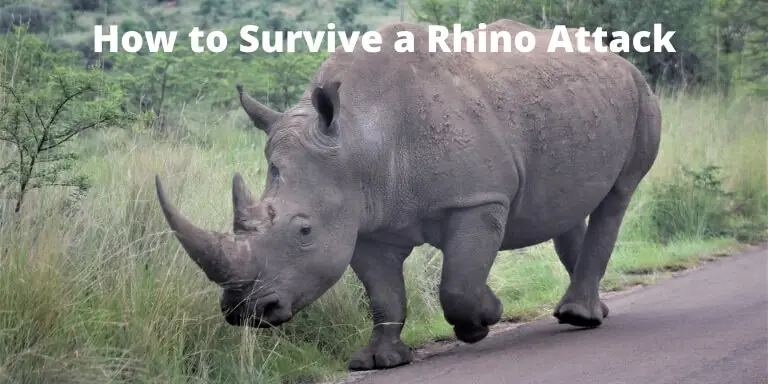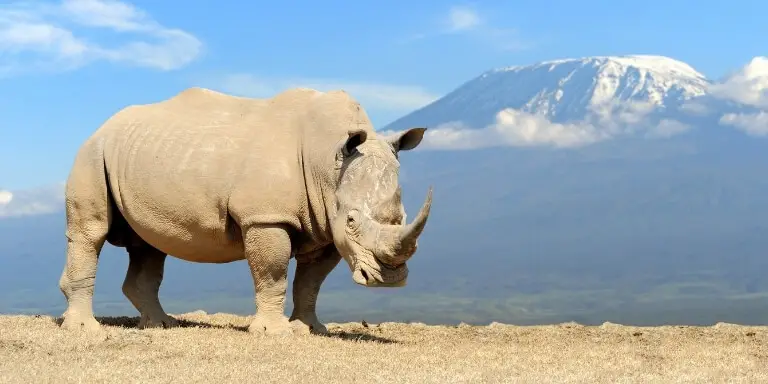Rhinoceros is the second-largest land mammal just after elephants and is considered a peaceful species. But these peace-loving creatures can charge at you at a shocking 50 kmph. But why do rhinos charge anyway? What provokes them to do so?
Lots of things can provoke a rhinoceros to charge at you. However, once the giant starts moving, only surviving it is what matters. So if you encounter one of them in the wild presenting some warning signs, you really need to start planning.

Rhinoceros physique in short

Body: The rhinoceros have an obvious resemblance to a walking rock. The first thing that comes to attention is it’s immense horns on the nose. The huge body is armored from top to bottom. It’s neck however is relatively short. The broad chests, huge humps & strong legs also catch the eye of an observer.
Size and weight: Rhinoceroses can grow up to 6.10 feet tall along with a body length of 12 to 14 feet. Male rhinoceros carry an average weight of 2300 kilograms. Females have an average weight of 1800 kilograms.
Horns: The majestic horns are made of keratin. Keratin is what human nails & hair are made of. Rhinoceroses have single or double horns according to different species. However, the prime horn can grow up to 20 inches.
Rhino horns are collected by people with money as a sign of status. For this, they need to kill these amazing creatures. The rhino population has been massacred by these ignorant people all over the world. As a result, their numbers have declined dramatically since the 1970s.
Speed: The momentum that these massive beasts can generate within the blink of an eye is truly jaw-dropping.
Their speed differs with species. White rhinos can run up to 50 kmph while the Black & Sumatran rhinoceros can reach a top speed of 55 kmph. This makes them impossible to outrun with tiny human legs.
Senses: All species of rhinoceros have very poor vision. But their lack of vision is backed up by their extraordinary senses for smelling & hearing.
How aggressive are Rhinoceroses?

The peace-loving mammals are not always so peace-loving. Rhinos will attack if it is provoked.
The creature generally detects humans with its auditory or olfactory senses. If it is taken by surprise, it tries to drive the offender away with no serious intention to injure.
They dislike killing humans. Less than two reports of rhino killings are found worldwide per year. After the threat is stabilized or no longer detected, it is most likely to run off.
Though rhinos seldom kills, that doesn’t mean it can’t gore you to a pulp. Even a gentle blow from a rhino can cause your body serious damage. 5 species of rhinoceros are still living in the world today. Not all of them are equally dangerous.
Black rhinos are considered to be the most dangerous species among the five. They are more nervous in nature than the other four. Black rhinoceroses respond energetically to any unfamiliar sound or smell.
Though the white rhinoceroses are bigger & heavier, they don’t mind human presence. They are rather inquisitive & will observe you from a distance. White ones are even seen to run along with a moving vehicle. Whereas the black species would charge vehicles until it is out of their sight.
Rhino aggression also depends on their social inclination. White rhinos are more social than black ones. In the wild, both species don’t go along well together. But they’re seen to make friends in captivity. So it can be concluded that their temperament depends a lot on how they were brought up.
Why do Rhinos charge?
Here are 5 reasons why do rhinos charge:
- Though rhinos are peaceful creatures, they are also immensely defensive. Also, they love their territory & protect it with all might. So if they ever feel intimidated about their territory, they’d attack straight away.
- Rhinos mostly charge out of fear and confusion. If one of them is taken by surprise in the wild, they’re most likely to drive the threat away by dashing toward it blindly.
- Sometimes rhinos attack trees or termite mounds just to let off some frustration. After all, the survival game in the wild is quite tough.
- Rhinoceroses love their children. The adult ones might not be vulnerable to predator attacks but babies are. So the concerned mother is seen as a guardian along the calf at all times.
- Rhinoceroses have very poor vision. For this reason, sometimes they end up dashing toward the thing that they wanted to get away from in the first place.

Red flags that you must avoid
Rhinos often give away some warning signs before attacking blindly. So if you are smart enough to notice these signs, you might actually save yourself from any fatal injury. If a rhinoceros is seen within close range from your safari, look out for these 3 red flags.
- Rhinoceros tend to lower their head pointing the horn toward the threat they feel. This is just a natural position they take before using their horn. In short, just look out for that terrible horn.
- If the giant starts snorting loudly, it means it is preparing to charge. So don’t get too close because even a gentle blow from a rhino can send you flying.
- Keep out from the playful calf of theirs. It may seem harmless but rhino calves are very inquisitive. It may come running toward you out of mere curiosity to find out what the new smell it feels in its nostrils. But as soon as it does that comes the nervous mother with her anxiety problems. An adult female can generate enough momentum to send you flying or to knock you off your car.
How to survive a Rhinoceros attack
The beast may be bigger, faster, and heavier and may also be impossible to be outrun in the wild. But it is possible to survive one using some instant tricks. It is best to move in the opposite direction as soon as the rhinoceros starts presenting some warning signs.

But what if you find yourself in a stand-off with the angry beast in the wild? Always do these 8 things to survive a dashing rhino.
- Stay frozen for a fair amount of time. The eyes of these herbivores are far away from each other. As a result, they don’t have binocular vision. So be still if you don’t want to be seen. If a rhinoceros can’t locate you, it won’t be able to attack you.
- Try hiding behind any big rock or termite mounds. The angry beast may lose interest if you keep out of it’s sight for a long time.
- Try climbing a tree. The huge beast obviously doesn’t have the physical adaptation required to climb a tree. But it surely has sheer strength to uproot one. So be wise and choose a tree with bigger and stronger roots to climb on.
- It is never a good idea to snap a photo with the adorable calf from up close. You mess with the calf, you get it’s mother’s horns, it is that simple. So leave the calf alone for some moment and try to make plans otherwise.
- Try moving in the direction of the wind. Rhinos have very strong olfactory senses. In fact, it even locates you by smelling your scent from a distance. So in case of emergency try to move downwind. Let the scent flow away with the wind. If it can’t smell you it can’t know where you are.
- Try running in a zigzag motion. Rhinos are big & heavy. So use their weight against them. Run through obstacles or over a rock or climb on a hill if possible.
- Try rolling in the other direction if the beast is really close and starts charging toward you immediately.
- Try to make loud noises. The herbivores have a very keen sense of hearing. Make weird and loud sounds to confuse the beast.
Conclusion
Studies have proven the fatality rate of a rhino to be more than 33%. That means, if you encounter one in the wild and try not to survive it, you are most likely to end up in the hospital or in the worst-case scenario end up dead. To avoid your head & important organs being hit and you may live another day to tell a story.
Related Post:
